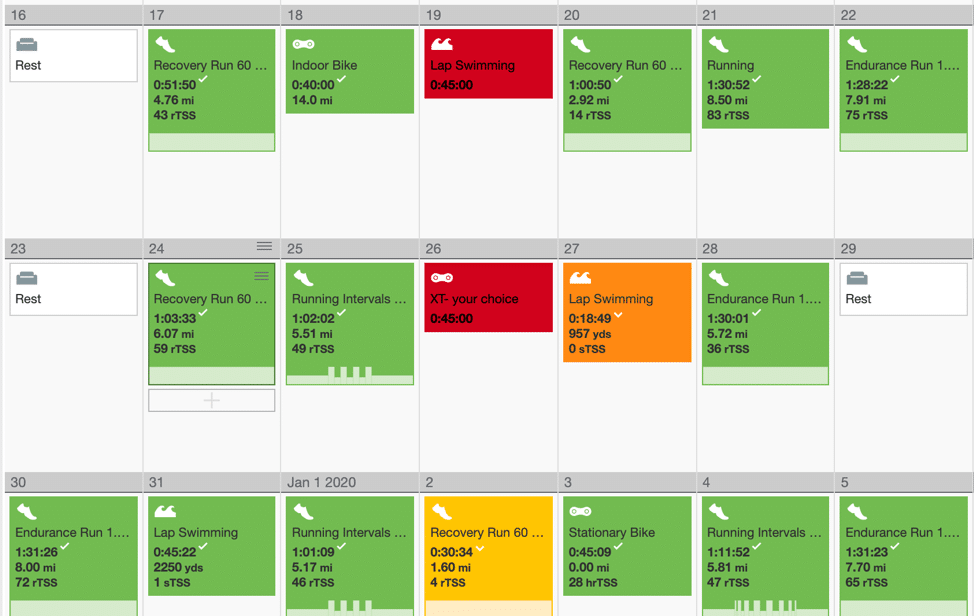
Garmin Outage? No Problem, Here’s the Workout Data That Really Matters
By Jason Koop,
Head Coach of CTS Ultrarunning
Garmin’s recent outage has been wreaking havoc on athletes. People have lost track of everything from their weekly mileage to vertical gain accumulated, and even the miles on their shoes. Some have even used the outage as an excuse to skip out on runs (if it didn’t happen on Strava, does it even matter?). When I first started coaching, we had watches and GPS monitors like we have today. And while the underlying technology has gotten progressively better each and every year, one of the biggest advances has been the ease with which athletes can harness, upload and share their data with others. What was once a painstaking process of getting a training file to your coach, involving multiple steps, proprietary cables, e-mails, different pieces of software and file type conversions is now as streamlined as stopping your watch. All of the data goes to where it needs to be without any further effort (until last week, that is).
Frustrated athletes and coaches using Garmin products over the past week have had to put this process in perspective. When it takes more than the press of a button to communicate what you have done to the rest of the world, what information will you prioritize? What data is actually useful? During this outage, I have had my athletes focus on the two points below and why that data is important.
Compliance: Did you do the run?
It’s a simple question, but compliance is one of the most important things we get from automatic uploads. Did you do the run and how close were you to what was prescribed? While most runs will include detail across several prescriptive variables, such as vertical gain/loss, RPE and the like, I base compliance on time prescribed vs actual time running. As a coach, I set customized color-coded flags in TrainingPeaks as a quick compliance check. Green means the run went to plan (+/- 20% of the planned time), yellow means the athlete was over or under the planned time buy 20-50%, orange means the runner went over/under the time by >50%, and red means the run did not happen at all. The tapestry of colors serves as a broad indicator of how well the athlete is sticking to the plan. Since the color-coded indicator is based on time, adjustments can be made to ensure that volume goals are being met.

Figure 1- Calendar from an athlete. Some workouts are compliant (green) some are not (yellow and orange) and other workouts have been missed entirely (red).
In my coaching experience, long term compliance (based on hourly volume) is one of, if not the biggest, indicators of success for an athlete. Over long periods of time, how well one stuck to the program will mean more than their longest long run, biggest weekly mileage or greatest amount of weekly vertical gain. So, first things first, track your compliance and you can make it as easy as ‘yes’, ‘no’ or ‘sort of’.
► Free Ultrarunning Training Assessment Quiz
Take our free 2-minute quiz to discover how effective your training is and get recommendations for how you can improve.
Perception: How did you feel?
If there is one thing I harp on when athletes enter information into training logs, it’s to include a post-activity comment on how they felt. Was the run hard or easy, did you feel light and flow down the trail or were you on the struggle bus the entire time? I look at how the athlete describes a training session before I delve into any of the specific metrics on mileage, heart rate (if applicable) or vertical gain. If an athlete is feeling great on a day to day basis, the plan can continue as is or even be moderately increased. If an athlete describes their workouts as hard, or that they were lacking energy, or something similar for more than a couple of days, it’s a good indication to back things off slightly.
Enjoying This Article? Get More Free Running Training Tips
Get our coaches' best training advice, delivered straight to your inbox weekly.
What about after the outage?
The above two items will get you 90% of the way there in terms of tracking your training and making effective decisions on when to increase, decrease or hold steady. Neither require any technology other than a pencil and paper. When Garmin’s systems come back online, the runs currently sitting your watch’s memory will be released to the world and you will once again have your pick of things to track and try to make sense of. Data you can capture from your Garmin, such as Normalized Graded Pace (NGP), Heart Rate Variability, and time sleeping all have their place, given the right athlete and the right circumstance.
The Garmin outage aside, we now have more things to track and monitor than time to process the information. Heart Rate Variability, blood biomarkers and even brain waves have all emerged as candidates to optimize your training, recovery and physiology. Whether or not they are viable candidates are another story entirely. I’ve written before about what data is worth tracking and why. If the Garmin outage has taught us anything, it’s that training can go on quite well, despite the absence of the mountain of data normally associated with every run. Yes, lots of data can make a difference if you know how to interpret it correctly, but you can also make great decisions about your training with just a little data, so long as it is reliable, accurate and most importantly actionable.

Comments 2
Running is getting over-complicated by the tech industry. Metrics are cool but they aren’t needed for health.
I’ve been trail running for 4 years now and have used a couple of smartwatches. I found that I didn’t need the metrics. Running by “feel” or naturally. Now I just use a solar/atomic Protrek that measures time and ascent/descent, that’s all I really want. No charging, updates or going out of date.
When running it feels so much better to be untethered from tech. It’s a free activity.
Yep! And, BTW, I just located the “activity” onmy watch (a dated .FIT file), after plugging it into my computer, and used the Upload feature on TrainingPeaks.
I was afraid (way too strong! LOL) that when I finally got my watch to sync (Garmin 920XT) it might double up runs, but everything came back on line and all worked fine last night.
My biggest challenge during the outage was that my watch band broke Sunday! I got on Amazon, ordered a new one and it got here yesterday (my rest day) and everything is back to “normal.”
LOLOL
Thanks for all you and Corrine have done to keep me sane! (There are some doubters, however. Don’t talk to my wife!)